
Editor’s note: This is the second of a two-part recap of the California
Breeders Showcase, more commonly called the California Spring Trials.
Part One ran in our July edition, including an introduction to the
trials. For that report and the trials overview, check out the Past
Issues section on the our website at www.greenhousecanada.com.
Part Two of our sampling of some of the top performers from this year’s California trials (Showcase)
Editor’s note: This is the second of a two-part recap of the California Breeders Showcase, more commonly called the California Spring Trials. Part One ran in our July edition, including an introduction to the trials. For that report and the trials overview, check out the Past Issues section on the our website at www.greenhousecanada.com.
‘Brasco Violet’ (1) is a large-flower brachyscome that will enhance any combination. Brasco will not overpower a combination but instead blends with the rest of the plant material. Brasco is also good in large containers and as a bedding plant.
The star in ‘Superbells Cherry Star’ (2) gives this calibrachoa a unique look within the vast selection of calibrachoa on the market – it does not have much competition yet. It is especially good in hanging baskets and combinations.
In addition, ‘Grape Punch’ (3), ‘Miss Lilac’ (4) and ‘Sweet Tart’ (5) are all new additions to the Superbells series. They look attractive, but they will only be successful if they have good garden performance, which we are going to find out this summer in the Sawaya Garden Trials.
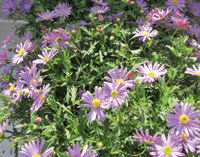
|
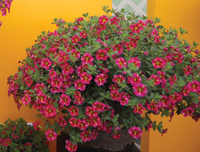
|
| 1 | 2 |
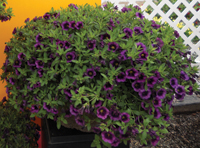 |
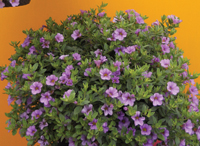 |
| 3 | 4 |
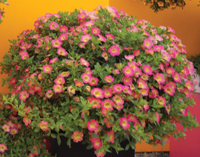 |
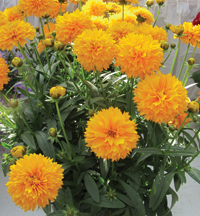 |
| 5 | 6 |
CALIBRACHOA CONTINUES TO ATTRACT MARKET ATTENTION
■ The calibrachoa genus is proving to be the most successful introduction since the impatiens debut in the early 1980s. These are good performers that look very good, whether from a distance of one metre or 100 metres.
‘Double Solana Golden Ball’ (6) is a double-flower coreopsis that is closing the gap between annuals and perennials. Solana flowers the entire summer, beginning with first-season production, and is excellent in combinations with other perennials or annuals. It is also great in any landscape.
Lucky Dahlia (7) is a bronze leaf series. It has vigorous growth, which makes it a good garden performer, and bears up well in the heat with somewhat smaller flowers. It performs especially well in landscapes or large pots.
Much like other diplodenia, ‘Summer Bell Soft Pink’ (8) loves the heat and puts on a great show in hanging baskets, in pots with trellises, or in large towers.
The key is not to try to grow them in Canada from a liner. It is an item to be imported from the south where the winters are much warmer and have a higher light intensity. It definitely needs to acclimatize before shipping.
‘White Hip Hop’ (9) and ‘White Manaus’ (10) are only two of the many new euphorbias on the market. The main difference is the level of vigour and the odd variety that has a different leaf colour.
Euphorbias are excellent in combinations as long you remember they are quite vigorous and you only need one cutting in a combination of four to eight other cultivars. Euphorbia is very deceiving, because when we plant it, it looks like two little sticks; however, once established, it can soon take over.
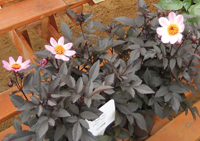 |
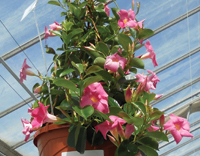
|
| 7 | 8 |
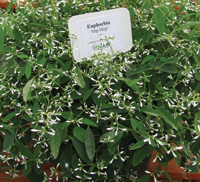 |
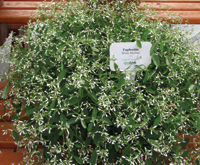 |
| 9 | 10 |
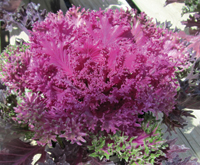
|
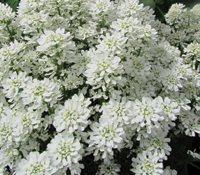
|
| 11 | 12 |
‘Glamour Red’ (11) flowering kale has a very red centre that will get redder with cooler temperatures. It is great in fall combinations or large landscapes and will sometimes last past Christmas!
‘Tahoe Snow White’ (12) ibris sempervirens is another perennial that flowers the first season and can be produced side by side with many annuals. It is good in perennial combinations or with other annuals.
‘Sweet Georgia Bewitched’ (13) ipomea is a dark-leaf variety. Its pointy leaf edges add a different look to any planter. It has excellent performance and greatly enhances many combinations. It works well when displayed in front of homes with mainly white brick, siding or porches.
‘Silver Stream’ (14) lobularia is another white variety that can be grown in 10” hanging baskets or larger, or in combinations with other varieties.
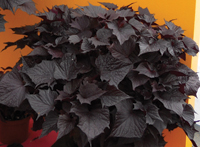 |
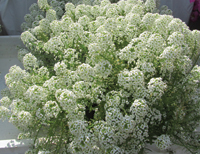 |
| 13 | 14 |
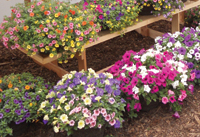 |
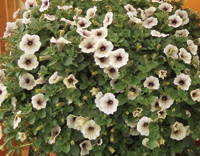 |
| 15 | 16 |
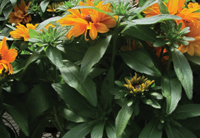 |
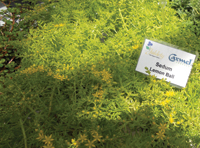 |
| 17 | 18 |
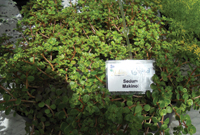 |
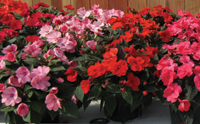 |
| 19 | 20 |
White goes with any other colour in combinations but caution has to be taken in this case because of the vigorous habit of ‘Silver Stream.’ One disadvantage of the lobularias on the market is the constant shedding of the white flowers that, if they landed on other crops, could be a source of botrytis.
BREEDERS CONTINUALLY SEARCHING FOR NEW MIXES
■ Here are mixed varieties of the Million Bells series and Surfinia (15). Every breeder is trying to market different mixes, which is a good thing for the grower, but three cultivars – especially of different species rooted in the same little liner – is a recipe for inferior quality combinations, in my opinion.
Breeders, educators and researchers keep telling us to space plants and not to stuff a container with too many cuttings.
The idea of trying to give us a sense of how different cultivars look together is great; however, having rooted cuttings in one little liner to be planted and finished like that could result in a disappointed customer who will not want to buy plants any more. The industry can’t afford to lose customers; what is needed are happy customers who want to buy even more plants!
‘White Russian’ (16) petunia has an antique white colour flower with a dark throat. It is good for 10” hanging baskets (or larger) and like other petunias loves the hot sun. When included in mixed containers, it adds character and is a definite enhancement.
‘Tiger Eye’ (17) rudbeckia is not a new variety but it is the best rudbekia on the market as long you treat it like a perennial. The longevity of its flowers is great – by the time you get the third set of flowers, the first set is still looking good.
Be careful if you are buying liners and make sure they are produced in short days without high-intensity supplemental lighting because this will initiate the flowers at an early stage and the plant will not be full enough.
‘Lemon Ball’ (18) and ‘Makinoi’ (19) are two varieties of a vast line of sedums on the market. They feature different leaf structures, textures and colours. Most are perennials and need very little maintenance and water. They are excellent when grown in 4” to 10” pots to be planted in well-drained grounds or rock gardens. They also work well in combinations in large hanging baskets that require watering once a week.
The Sunpatiens Series (20) is truly an impatiens that loves the sun and performs very well. It consists of two groups – one that’s very vigorous for large landscapes, and the other that’s relatively compact for smaller landscapes.
It is my preference to use the vigorous variety and plant fewer plants. I know this is not Grower Economics 101, but we need successful gardeners if we are to have a successful business. Sunpatiens are to be grown in 6” and larger pots.
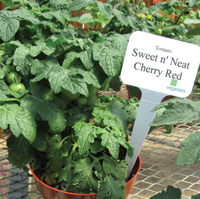 |
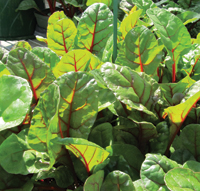
|
| 21 | 22 |
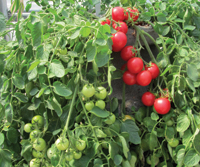 |
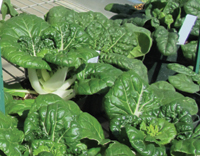 |
| 23 | 24 |
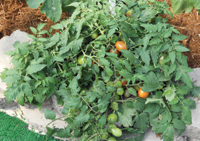 |
25 |
SOME IMPRESSIVE VARIETIES FOR VEGETABLE MARKETING
■ Here are some of the vegetable varieties to share with you: ‘Sweet & Neat Cherry Red’ (21), ‘Swiss Chard Celebration’ (22), ‘Tomato Cherry Falls’ (23), ‘Toy Choy’(24), and ‘Tumbling Tiger’ (25).
As growers or retailers, we should not charge ridiculous prices for vegetable plants. Talk about indigestion. Sales of vegetables packed properly and priced moderately are on the increase, so let us not kill the goose that lays the golden eggs.
And a final, important note: initially try any variety new to your operation on a small scale. Evaluate how it performs and increase its production if it performs well, or delete it.
Most of the varieties mentioned in this article and the July feature are in the Sawaya Garden Trials (near Simcoe, Ontario) and other trial and display garden locations throughout North America. Check them out yourself! ■
Melhem Sawaya of Focus Greenhouse Management is a consultant and research coordinator to the horticultural industry. Comments on this or any other article are always welcome; e-mail mel@focusgreenhousemanagement.com, or visit www.focusgreenhousemanagement.com.
Print this page